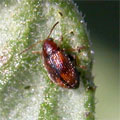roOTSTOCK
Till 1990’s Vines in India were mostly grown on their own roots, as most grape growing areas were considered free from the soil borne problems. However, interest in rootstocks has intensified in later years, owing to the problems of salinity, drought and low vine vigour. Among many rootstocks introduced and tested in India, Dogridge rootstock has been found promising for its drought tolerance. However, wherever soils are sodic with higher concentration of sodium, and in regions where irrigation water is with more EC (> 1 dsm-1) some of the rootstocks like 110R and 1103P are prove to be better as they have capacity to exclude sodium in addition to their good drought tolerance capacity. Rootstocks are being employed for cultivating seedless grape varieties, while varieties such as Gulabi, Bangalore Blue and Dilkush are grown on their own roots. Make the decision well in advance about employing rootstock, after site inspection and other considerations of water and soil types.
Steps to raise a vineyard on rootstock and in situ grafting are outlined below:
Grape Rootstock
·
Obtain genetically pure and true to type rooted cuttings of
rootstocks/planting material from genuine source
to avoid genetic admixtures
·
The best time for planting rootstocks in the field is during Mid
January to March.
·
Open the trenches of 2.5’ depth and 2.5’ width in North-South
direction of desired length.
This should be done at least one month before planting to
facilitate weathering of opened trenches.
·
A mixture of top
soil, 50 kg farm yard manure, 3 kg of bone meal, 2 kg of castor cake,
pongamia cake or neem cake and 2 kg of super phosphate is used to
fill 2/3 portion of the trench. The rest 1/3rd portion is
filled with the mixture of subsoil and farmyard manure. Water is let
copiously into the trench after filling, in order to make the soil
settle properly.
·
At the time of planting, open the pits (90 cm3) at the
desired planting distance (5-6 ft) on already filled trenches
·
Plant the rooted cuttings in the opened pits and irrigate immediately
to avoid mortality
·
After 15-30 days of planting apply fertilizers such as 19:19:19 and
urea alternately either through fertigation or soil application for
good growth of rootstocks.
·
After 3-4 months, cut and remove all the shoots retaining only two
vigorous shoots.
·
Give bamboo stick support to these shoots and allow them to grow and
attain pencil thickness when it is ready for grafting.
·
Wedge graft the stocks with scion of desired variety during
September-October at a height of 30-40 cm giving sufficient height on
the stock plant for earthing up. The selection of the scion should be
made carefully so that the diameter of both stock and scion should
match. It is always advised to graft two shoots per vine
·
Care should be taken to remove suckers developed on rootstock portion
as these shoots compete for water and nutrients with sprouted new
shoots on scions.
·
Once the new shoots start growing, train the shoots straight by tying
to bamboo sticks
·
Around 45 days after grafting when once the success of graft is
confirmed, retain only one shoot with a successful graft.
·
As grafted plants start growing, simultaneously girth of graft union
starts increasing. As a result the tied polythene strip may casus
girdling effect in grafted region. Hence, the tied polythene strips
should be removed carefully and retie the grafted region with new
polythene strip.
·
Allow it to grow and train the vines according to the training system
adopted. If trained to 'Y' trellis it is better to provide four arms
with ‘H’ system of training.
·
Uniformity in growth of all vines may be achieved by taking re-cut in
the following January – February months. The re-cut is done by
retaining only 2-3 buds above graft joint.


